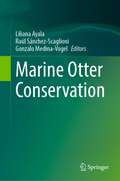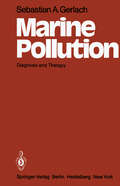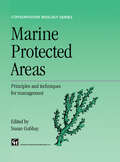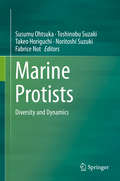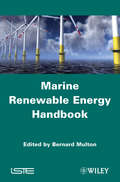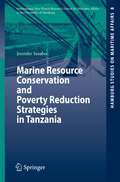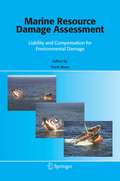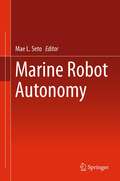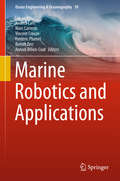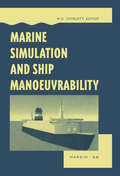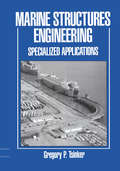- Table View
- List View
Marine Ornamental Species Aquaculture
by Ricardo Calado Ike Olivotto Miquel Planas Oliver G. Joan HoltThe global trade of aquatic organisms for home and public aquariums, along with associated equipment and accessories, has become a multi-billion dollar industry. Aquaculture of marine ornamental species, still in its infancy, is recognized as a viable alternative to wild collection as it can supplement or replace the supply of wild caught specimens and potentially help recover natural populations through restocking. This book collects into a single work the most up-to-date information currently available on the aquaculture of marine ornamental species. It includes the contributions of more than 50 leading scientists and experts on different topics relevant for the aquaculture of the most emblematic groups of organisms traded for reef aquariums. From clownfish, to angelfish, tangs and seahorses, as well as corals, anemones, shrimps, giant clams and several other reef organisms, all issues related with the husbandry, breeding, and trade are addressed, with explanatory schemes and illustrations being used to help in understanding the most complex topics addressed. Marine Ornamental Species Aquaculture is a key reference for scientists and academics in research institutes and universities, public and private aquaria, as well as for hobbyists. Entrepreneurs will also find this book an important resource, as the culture of marine ornamental species is analyzed from a business oriented perspective, highlighting the risks and opportunities of commercial scale aquaculture of marine ornamentals.
Marine Otter Conservation
by Liliana Ayala Raúl Sánchez-Scaglioni Gonzalo Medina-VogelThis book offers a multidisciplinary approach to conservation issues related to the marine otter (Lontra felina). The main goal is the systematization of different research efforts on this species, to contribute with conservation policy design and implementation. The authors contribute their achievements in conservation, ecology, status in freshwater habitats, habitat fragmentation effects, interaction with human activities and recommendations for an effective conservation of the species. The book is directed first and foremost towards researchers and authorities and people involved in conservation tasks of otters.Despite in the last decades some studies and efforts on Lontra felina has carried in Peru and Chile, some information can be gathered to fill the gaps on marine otter conservation in Peru. That is the main goal of the book Conservation of Marine Otter. Moreover, the publication will be the first book published at international level on Lontra felina with the participation of several experimented researchers on this threatened and endemic species.
Marine Painting Manual
by A.M. BerendsenIt is a pleasure to introduce to the reader this new Marine Painting Manual. The previous edition, entitled Ship Painting Manual, was published in 1975. Since then a number of new technological developments have taken place. Also, standards with regard to safety, health and the environment have become more severe. These changes called for a thoroughly revised and updated Marine Painting Manual. I believe that the editor should be congratulated on having completed this task in such a commendable way. I hope that this new volume will find as enthusiastic a response among those concerned with maritime affairs as its predecessor did some fifteen years ago. - Dr. Jan Raat, Director Netherlands Foundation for the Co-ordination of Maritime ResearchThe Marine Painting Manual sets out to provide clear guidelines for the effective protection of marine structures, ocean-going vessels and offshore platforms. Painting is a high cost procedure and is a crucial factor in determining the life and subsequent maintenance of steel structures in the marine environment. The book is a follow-up to the Ship Painting Manual published in 1975. It has been completely revised, partly rewritten and an additional chapter on offshore structures included. The present volume contains detailed and up-to-date information on all aspects of the preparation and painting for the protection of marine structures.
Marine Plastics: Innovative Solutions to Tackling Waste
by Siv Marina Flø Grimstad Lisbeth Mølgaard Ottosen Neil A. JamesThis open access book reflects aims of the Blue Circular Economy (BCE) project, which focused on small and medium-sized enterprises (SMEs) aiming to create value using circular economy concepts related to products and services within fishing gear recycling in the Northern Periphery and Arctic (NPA) area. Cluster establishment and operation were carried out in collaboration with academia, industry and government agencies following a triple-helix approach. Discarded fishing gear constitutes a large part of marine plastics. Preventing future discharge of fishing gear into the ocean is a vital step in combating plastic pollution. Circular economy is one of the tools in the European Green deal, targeting waste minimisation. Closing the loop for waste fishing nets by transferring them to a resource could be a solution for preventing discharge at sea: exploring this opportunity is at the core of this book.
Marine Pollution: Diagnosis and Therapy
by Sebastian A. GerlachWhen, in 1966, the Gennan Research Society directed the attention of oceanographers in the Federal Republic of Ger many to problems of marine pollution, I was not enthusiastic. Emphasis on this problem area meant that other important research plans had to be postponed. But the lectures at the Third International Oceanographic Congress, September 1970, in Tokyo, and at the FAO Conference on Marine Pollution and its Effects on Living Resources and Fishing, December 1970, in Rome, convinced me that research on problems of marine pollution is a social obligation, and that the oceanographer has to take a stand. I issued public warnings about the continuing use of pesticides and had to defend myself against protests by the fishing industry and many colleagues who were, in Novem ber 1970, unaware of the extent of the threat. Thus, I was required by my profession to acquire an overview of the prob lems of ocean pollution. In 1971 I only needed to familiarize myself with some one hundred bibliographical items. In the interim, the flood of data has risen dramatically, and in the year 1975, no fewer than 868 publications under the heading of "Marine Pollution" were reported (Table 1). It is, therefore, more and more diffi cult to distinguish new results of scientific research from the many repetitions and variations, and I fear that from year to year my efforts to illustrate the actual status of the problem at a given moment will be subject to more gaps.
Marine Pollution and Climate Change
by Andrés Hugo Arias Jorge Eduardo HugoThis book presents a broad overview of pollution issues facing climatic, economic, and legal globalization. Topics include changes in oceans from ancient times to the present, the importance of marine currents and changing climates, marine pollution linked to climate change (fossil fuels, global carbon dioxide, heavy metals, pesticides, plastics, emerging pollutants, and marine debris), global shipping and species invasion, global climate change in the Arctic and Antarctic environments, and regulatory responses to mitigate pollution and climate change in oceans.
Marine Pollution and Climate Change
by Andrés Hugo Arias Jorge Eduardo MarcovecchioThis book presents a broad overview of pollution issues facing climatic, economic, and legal globalization. Topics include changes in oceans from ancient times to the present, the importance of marine currents and changing climates, marine pollution linked to climate change (fossil fuels, global carbon dioxide, heavy metals, pesticides, plastics, emerging pollutants, and marine debris), global shipping and species invasion, global climate change in the Arctic and Antarctic environments, and regulatory responses to mitigate pollution and climate change in oceans.
Marine Pollution and Microbial Remediation
by Milind Mohan Naik Santosh Kumar DubeyMarine environment is the largest habitat covering approximately 70% of the total earth surface. Oceans are the main regulatory agent of earth’s climate and harbour a huge diversity of living organisms. Marine environment provide a unique ecological niche to different microbes which play a significant role in nutrient recycling as well as various environmental activities. However with rapid industrialization, urbanisation, ship trafficking and mining activities enormous amounts of waste including heavy metals, hydrocarbons, chemicals, dyes, organic load, agriculture waste, pesticides, antifoulants (e.g. tributyltin) and bacterial pathogens have accumulated in marine/estuarine environments over several decades and pose a serious threat to marine macro and micro biota and humans and therefore require special attention. However some natural marine microbes are known to possess diverse resistance mechanisms and degradation pathways to variety of toxic pollutants and these unique characteristics of marine/estuarine bacteria proved to be an ideal tool in bioremediation of contaminated marine and estuarine environmental sites. Reclamation of marine polluted environments using marine microbes has been found to be effective, affordable and ecofriendly technological solution over conventional physical and chemical methods.Objective of this book is focus on marine pollution and application of marine microorganisms in cost effective and ecofriendly methods of pollution abatement.
Marine Polysaccharides: Advances and Multifaceted Applications
by Shakeel Ahmed Aisverya SoundararajanIn the past few decades, marine organisms, including macroalgae and microalgae, have been extensively explored as potential sources of bioactive compounds with applications in various fields such as pharmaceuticals, biomedicine, cosmetics and foodstuffs. Marine polysaccharides, such as chitin/chitosan, ulvans, fucans, alginates and carrageenans, are biochemical compounds with several important properties such as anticoagulant and/or antithrombotic, immunomodulatory, antitumor, antilipidemic, hypoglycemic, antibiotic, anti-inflammatory and antioxidant properties. Due to their biocompatible, nontoxic and biodegradable nature, marine polysaccharides offer a better alternative to be used in advancement of the biomedical field. This book focuses on marine polysaccharides; their derivatives, blends, composites and hydrogels; and their multifaceted applications in various fields. The book also discusses the various aspects of marine polysaccharides from the point of view of chemistry and related applications. It is an important reference for marine biotechnologists, natural product scientists, students, researchers and academicians working in the area of materials science, marine science and polymer chemistry.
Marine Polysaccharides: Advances and Multifaceted Applications
by Shakeel Ahmed Aisverya SoundararajanIn the past few decades, marine organisms, including macroalgae and microalgae, have been extensively explored as potential sources of bioactive compounds with applications in various fields such as pharmaceuticals, biomedicine, cosmetics and foodstuffs. Marine polysaccharides, such as chitin/chitosan, ulvans, fucans, alginates and carrageenans, are biochemical compounds with several important properties such as anticoagulant and/or antithrombotic, immunomodulatory, antitumor, antilipidemic, hypoglycemic, antibiotic, anti-inflammatory and antioxidant properties. Due to their biocompatible, nontoxic and biodegradable nature, marine polysaccharides offer a better alternative to be used in advancement of the biomedical field. This book focuses on marine polysaccharides; their derivatives, blends, composites and hydrogels; and their multifaceted applications in various fields. The book also discusses the various aspects of marine polysaccharides from the point of view of chemistry and related applications. It is an important reference for marine biotechnologists, natural product scientists, students, researchers and academicians working in the area of materials science, marine science and polymer chemistry.
Marine Power Plant
by Zongming Yang Huabing Wen Xinglin Yang Viktor Gorbov Vira Mitienkova Serhiy SerbinThis book describes the history and development of marine power plant. Problems of arrangement, general construction and parameters of marine power plants of all types are considered. It also introduces different characteristics of each type of marine power plant, matching characteristic for diesel propulsion. The book gives a clear idea about different marine power engines, including working principle, structure and application. Readers will understand easily the power system for ships since there are a lot of illustrations and instructions for each of the equipment. This book is useful for students majoring in “marine engineering”, “energy and power engineering” and other related majors. It is also useful for operators of marine institution for learning main design and operation of ship plants.
Marine Protected Areas: Principles and techniques for management (Conservation Biology #5)
by SusanGubbayMarine protected areas (MPAs) have an important role in marine conserva tion programmes around the world. Although most have been established relatively recently when compared with protected areas on land, there is considerable expertise on their identification, setting up and management. Some techniques have been adapted from those used on land. Others are novel, and unique to marine conservation. The chapters in this book give an insight into this fast developing field where experiment and innovation work alongside techniques which have been tried and tested. The guiding princi ples behind key stages in the setting up and management of MP As are described, and case studies illustrate how they have worked. While it is most encouraging to read about the successes, the case studies also point to difficulties which have been encountered. Not all of the examples are new or recent but, together, they illustrate what is happening in this field.
Marine Proteins and Peptides: Biological Activities and Applications
by Se-Kwon KimFood proteins and bioactive peptides play a vital role in the growth and development of the body’s structural integrity and regulation, as well as having a variety of other functional properties. Land animal-derived food proteins such as collagen and gelatine carry risks of contamination (such as BSE). Marine-derived proteins, which can provide equivalents to collagen and gelatin without the associated risks, are becoming more popular among consumers because of their numerous health beneficial effects. Most marine-derived bioactive peptides are currently underutilized. While fish and shellfish are perhaps the most obvious sources of such proteins and peptides, there is also the potential for further development of proteins and peptides from sources like algae, sea cucumber and molluscs. Marine-derived proteins and peptides also have potential uses in novel products, with the possibility of wide commercialization in the food, beverage, pharmaceutical and cosmetic industries, as well as in other fields such as photography, textiles, leather, electronics, medicine and biotechnology. Marine Proteins and Peptides: Biological Activities and Applications presents an overview of the current status, future industrial perspectives and commercial trends of bioactive marine-derived proteins and peptides. Many of the industrial perspectives are drawn from the food industry, but the book also refers to the pharmaceutical and cosmetics industries. There have recently been significant advances in isolating functional ingredients from marine bio-resources and seafood by-products for use in these industries, but little has been published, creating a knowledge gap, particularly with regard to the isolation and purification processes. This book is the first to fill that gap. Marine Proteins and Peptides: Biological Activities and Applications is a valuable resource for researchers in marine biochemistry field as well as food industry managers interested in exploring novel techniques and knowledge on alternative food protein sources. It will become a standard reference book for researchers involved in developing marine bio-resources and seafood by-products for novel nutraceutical, cosmetics, and pharmaceutical applications. It will also appeal to managers and product developers in the food, pharmaceutical and cosmetics industries, particularly those looking to use marine-derived proteins and peptides as substitutes or replacements for unfashionable or outdated food components.
Marine Proteins and Peptides: Biological Activities and Applications
by Se-Kwon KimFood proteins and bioactive peptides play a vital role in the growth and development of the body’s structural integrity and regulation, as well as having a variety of other functional properties. Land animal-derived food proteins such as collagen and gelatine carry risks of contamination (such as BSE). Marine-derived proteins, which can provide equivalents to collagen and gelatin without the associated risks, are becoming more popular among consumers because of their numerous health beneficial effects. Most marine-derived bioactive peptides are currently underutilized. While fish and shellfish are perhaps the most obvious sources of such proteins and peptides, there is also the potential for further development of proteins and peptides from sources like algae, sea cucumber and molluscs. Marine-derived proteins and peptides also have potential uses in novel products, with the possibility of wide commercialization in the food, beverage, pharmaceutical and cosmetic industries, as well as in other fields such as photography, textiles, leather, electronics, medicine and biotechnology. Marine Proteins and Peptides: Biological Activities and Applications presents an overview of the current status, future industrial perspectives and commercial trends of bioactive marine-derived proteins and peptides. Many of the industrial perspectives are drawn from the food industry, but the book also refers to the pharmaceutical and cosmetics industries. There have recently been significant advances in isolating functional ingredients from marine bio-resources and seafood by-products for use in these industries, but little has been published, creating a knowledge gap, particularly with regard to the isolation and purification processes. This book is the first to fill that gap. Marine Proteins and Peptides: Biological Activities and Applications is a valuable resource for researchers in marine biochemistry field as well as food industry managers interested in exploring novel techniques and knowledge on alternative food protein sources. It will become a standard reference book for researchers involved in developing marine bio-resources and seafood by-products for novel nutraceutical, cosmetics, and pharmaceutical applications. It will also appeal to managers and product developers in the food, pharmaceutical and cosmetics industries, particularly those looking to use marine-derived proteins and peptides as substitutes or replacements for unfashionable or outdated food components.
Marine Protists: Diversity and Dynamics
by Susumu Ohtsuka Toshinobu Suzaki Takeo Horiguchi Noritoshi Suzuki Fabrice NotThis comprehensive book provides a unique overview of advances in the biology and ecology of marine protists. Nowadays marine protistology is a hot spot in science to disclose life phenomena using the latest techniques. Although many protistological textbooks deal with the cytology, genetics, ecology, and pathology of specific organisms, none keeps up with the quick pace of new discoveries on the diversity and dynamics of marine protists in general. The bookMarine Protists: Diversity and Dynamics gives an overview of current research on the phylogeny, cytology, genomics, biology, ecology, fisheries, applied sciences, geology and pathology of marine free-living and symbiotic protists. Poorly known but ecologically important protists such as labyrinthulids and apostome ciliates are also presented in detail. Special attention is paid to complex interactions between marine protists and other organisms including human beings. An understanding of the ecological roles of marine protists is essential for conservation of nature and human welfare. This book will be of great interest not only to scientists and students but also to a larger audience, to give a better understanding of protists’ diverse roles in marine ecosystems.
Marine Renewable Energy: Resource Characterization and Physical Effects
by Zhaoqing Yang Andrea CoppingThis complete reference to marine renewable energy covers aspects of resource characterization and physical effects of harvesting the ocean’s vast and powerful resources—from wave and tidal stream to ocean current energy. Experts in each of these areas contribute their insights to provide a cohesive overview of the marine renewable energy spectrum based on theoretical, numerical modeling, and field-measurement approaches. They provide clear explanations of the underlying physics and mechanics, and give close consideration to practical implementation aspects, including impacts on the physical system. Engineers, researchers, and students alike will find invaluable tools and studies that will aid them in realizing significant sustainable energy production from near-shore and ocean environments.
Marine Renewable Energy Handbook
by Bernard MultonMarine renewable energy is a significant resource for generating electricity, and if some conversion technologies have already reached a certain level of maturity, others are emerging. The originality of this multidisciplinary book is to offer a broad spectrum of knowledge from academic and industry experts of various origins. It deals with general aspects such as the specificities and constraints of the marine environment, the concepts of hydrodynamics and ocean engineering, as well as the industrial and economic sides necessary for the assembly of projects. It also discusses conversion technologies such as offshore wind, tidal power plants, tidal stream turbines, wave energy converters and ocean thermal energy plants. Finally, two chapters are devoted to power electronic conversion and power transmission cables.
Marine Renewable Energy Handbook
by Bernard MultonMarine renewable energy is a significant resource for generating electricity, and if some conversion technologies have already reached a certain level of maturity, others are emerging. The originality of this multidisciplinary book is to offer a broad spectrum of knowledge from academic and industry experts of various origins. It deals with general aspects such as the specificities and constraints of the marine environment, the concepts of hydrodynamics and ocean engineering, as well as the industrial and economic sides necessary for the assembly of projects. It also discusses conversion technologies such as offshore wind, tidal power plants, tidal stream turbines, wave energy converters and ocean thermal energy plants. Finally, two chapters are devoted to power electronic conversion and power transmission cables.
Marine Resource Conservation and Poverty Reduction Strategies in Tanzania (Hamburg Studies on Maritime Affairs #8)
by Jennifer K. SesaboThe Tanzanian coastal areas are socially, nutritionally, economically and environmentally important, yet they are vulnerable to both over-exploitation and degradation of their habitats. This book demonstrates the extent which various socio-economic dimensions of rural coastal households influence livelihood pathways, production efficiency and attitudes towards conservation initiatives.
Marine Resource Damage Assessment: Liability and Compensation for Environmental Damage
by F. MaesThe main focus of this important book is on civil liability regimes to compensate for ecological/environmental damage, the impact of EC decision-making on the international regime for oil pollution damage, the use of environmental funds in this respect, the economic valuation of damage to the environment from a theoretical perspective and the application of the Contingent Valuation Method in Belgium for ecological damage at sea.
Marine Robot Autonomy
by Mae L. SetoAutonomy for Marine Robots provides a timely and insightful overview of intelligent autonomy in marine robots. A brief history of this emerging field is provided, along with a discussion of the challenges unique to the underwater environment and their impact on the level of intelligent autonomy required. Topics covered at length examine advanced frameworks, path-planning, fault tolerance, machine learning, and cooperation as relevant to marine robots that need intelligent autonomy.
Marine Robotics and Applications (Ocean Engineering & Oceanography #10)
by Luc Jaulin Andrea Caiti Marc Carreras Vincent Creuze Frédéric Plumet Benoît Zerr Annick Billon-CoatThis book reports on findings at the intersection between two related fields, namely coastal hydrography and marine robotics. On one side, it shows how the exploration of the ocean can be performed by autonomous underwater vehicles; on the other side, it shows how some methods from hydrography can be implemented in the localization and navigation of such vehicles, e.g. for target identification or path finding. Partially based on contributions presented at the conference Quantitative Monitoring of Underwater Environment, MOQESM, held on October 11-12, 2016, Brest, France, this book includes carefully revised and extended chapters presented at the conference, together with original papers not related to the event. All in all, it provides readers with a snapshot of current methods for sonar track registration, multi-vehicles control, collective exploration of underwater environments, optimization of propulsion systems, among others. More than that, the book is aimed as source of inspiration and tool to promote further discussions and collaboration between hydrographers, robotic specialists and other related communities.
Marine Simulation and Ship Manoeuvrability: Proceedings of the international conference, MARSIM '96, Copenhagen, Denmark, 9-13 September 1996
by M. S. ChislettReal-time, interactive ship simulators limped onto the scene, in the wake of flight simulators, some years ago. The maritime industries have a long history of conservatism, but this is now changing rapidly. The information age has also swept over ships and shipping, and has been taken to heart to such an extent that, for example, flight simulators now cooperate with ship simulators and import useful new concepts and methodologies. The more than 50 papers contained in this book show what and why. Although traditionally conservative, the marine world is also traditionally international and this has not changed. The papers in the book are by leading authors from all over the world and provide a detailed snap-shot of the rapidly advancing state-of-the-art, together with pointers to the future. The overall theme of MARSIM '96 and therefore also of this book is: Vessel manouevrability and marine simulation research, training and assessment, and includes original papers on topics such as bridge resource management, distant learning and simulators coupled via The Internet, virtual reality, neural networks, rudder-propeller hydrodynamics, prime mover models, squat in shallow water, and many more.
Marine Simulation and Ship Manoeuvrability: Proceedings of the international conference, MARSIM '96, Copenhagen, Denmark, 9-13 September 1996
by M. S. ChislettReal-time, interactive ship simulators limped onto the scene, in the wake of flight simulators, some years ago. The maritime industries have a long history of conservatism, but this is now changing rapidly. The information age has also swept over ships and shipping, and has been taken to heart to such an extent that, for example, flight simulators now cooperate with ship simulators and import useful new concepts and methodologies. The more than 50 papers contained in this book show what and why. Although traditionally conservative, the marine world is also traditionally international and this has not changed. The papers in the book are by leading authors from all over the world and provide a detailed snap-shot of the rapidly advancing state-of-the-art, together with pointers to the future. The overall theme of MARSIM '96 and therefore also of this book is: Vessel manouevrability and marine simulation research, training and assessment, and includes original papers on topics such as bridge resource management, distant learning and simulators coupled via The Internet, virtual reality, neural networks, rudder-propeller hydrodynamics, prime mover models, squat in shallow water, and many more.
Marine Structures Engineering: Specialized applications
by Gregory TsinkerMarine Structures Engineering is designed to help engineers meet the growing worldwide demand for construction of new ports and the modernization of existing ports and terminals. It provides an authoritative guide to the design, construction, rehabilitation, repair, and maintenance of port and harbor structures. Each chapter is self-contained, allowing readers to access specific information. The Author draws on his extensive experience in offshore structure and port engineering to demonstrate evaluation, rehabilitation, repair, and maintenance of in-service marine structures. Also covered in detail are state-of-the-art approaches to: *marine structures in cold regions, with special attention to the role of ice loads, permafrost, and other ice effects *shiplifts, marine railways, shipways, and dry docks *offshore moorings *floating breakwaters *marinas *structures that protect bridge piers from ship impact. Offering practical information on all aspects of marine structures, this book serves as an indispensable resource to all engineers and professionals involved in design, construction, maintenance, and modernization of ports and harbors.

